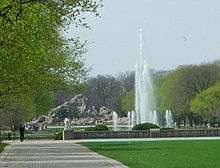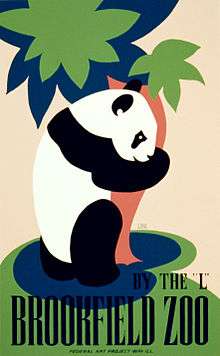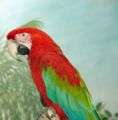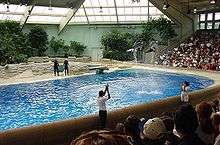Brookfield Zoo
 Roosevelt Fountain, with Ibex Island in the background | |
| Date opened | July 1, 1934 |
|---|---|
| Location | Brookfield, Illinois, USA |
| Coordinates | 41°49′58″N 87°50′00″W / 41.832671°N 87.833462°WCoordinates: 41°49′58″N 87°50′00″W / 41.832671°N 87.833462°W |
| Land area | 216 acres (87 ha) |
| Number of animals | 2300 |
| Number of species | 450 |
| Memberships | AZA[1] |
| Public transit access | BNSF Hollywood |
| Website |
www |
Brookfield Zoo, also known as the Chicago Zoological Park,[2][3] is a zoo located in the Chicago suburb of Brookfield, Illinois. It houses around 450 species of animals in an area of 216 acres (87 ha). It opened on July 1, 1934,[4] and quickly gained international recognition for using moats and ditches instead of cages to separate animals from visitors and from other animals. The zoo was also the first in America to exhibit giant pandas, one of which (Su Lin[5]) has been taxidermied and put on display in Chicago's Field Museum of Natural History. In 1960, Brookfield Zoo built the nation's first fully indoor dolphin exhibit, and in the 1980s, the zoo introduced Tropic World, the first fully indoor rain forest simulation and the then-largest indoor zoo exhibit in the world.
The Brookfield Zoo is owned by the Cook County Forest Preserve District and managed by the Chicago Zoological Society. The Society sponsors numerous research and conservation efforts globally.
History

In 1919, Edith Rockefeller McCormick donated land she had received from her father as a wedding gift to the Cook County Forest Preserve District for development as a zoological garden. The district added 98 acres (400,000 m2) to that plot and in 1921, the Chicago Zoological Society was established. Serious construction did not begin until 1926, after a zoo tax was approved. Construction slowed during the Great Depression, but regained momentum by late 1931. Construction went on at an increased pace[6] and the zoo opened on July 1, 1934.[7] By the end of September 1934, over one million people had visited the new zoo;[8] the four millionth visitor was just two years later.[9]
The 1950s saw the addition of a veterinary hospital,[10] a children's zoo,[11] and the famous central fountain.[12] The zoo went through a decline in the 1960s until a large bond issue from the Forest Preserve District, close attention to zoo governance, and visitor services saw the zoo recreate itself as one of the nation's best. Tropic World, the then-largest indoor zoo exhibit in the world, was designed by French architect Pierre Venoa and opened in three phases (Africa, Asia, and South America) between 1982 and 1984.[13]
During the zoo's early decades, a mini-railroad existed, which carried guests around the outer perimeter of the park from the North Gate to the old seven seas dolphin habitat on the park's south end. The railroad was dismantled in the mid 1980s, although the pathways once used by the train still exist as roads for service vehicles, as does the North Gate station (since converted into a snack stand)

In the early 21st century, the zoo has undergone significant capital upgrades, constructing the Regenstein Wolf Woods, the Hamill Family Play Zoo, butterfly tent, sheltered group catering pavilions, and the largest non-restored, hand-carved, wooden carousel in the United States. Great Bear Wilderness, a new, sprawling habitat, opened in 2010. The interiors of several existing buildings were reconfigured into immersion exhibits, based upon ecosystems rather than by clades; these include The Swamp, the Fragile Rain Forest, Fragile Desert (the Sahara desert of North Africa) the Living Coast (the shores of Chile and Peru), the African Savanna, and Australia House.
The Zoo's reptile house, the first building to open in 1934, was closed in December 2004 and is being converted into a conservation center which will not display live animals but will detail the zoo's larger conservation mission. The children's zoo was dismantled in early 2013, along with the abandoned bear grottos, for future development projects.
Because of the expense of constructing Great Bear Wilderness and protests from In Defense of Animals over the deaths of the zoo's African elephants, the Pachyderm House was closed for a year in 2011 for modifications and no longer exhibits elephants or hippopotamuses. The building dates back to 1934 and currently houses only rhinoceroses, tapirs, and pygmy hippos.
The Brookfield Zoo is also known for its majestic fountain named after the 26th president of the United States, Theodore Roosevelt. On some days, the fountain's spouting water can reach up to 60 feet high.
The Zoo has been closed only three times in its history: On September 14, 2008, after damage from a weekend rainstorm; on February 2, 2011, after a major blizzard; and April 18–19, 2013, after flooding from a severe rainstorm.
Animals
- Dolphins
The Seven Seas at CZS or Brookfield Zoo currently has 8 atlantic bottlenose dolphins. Allie(F), Tapeko(F), Spree(F), Noelani(F), Allison(F), Merlin(M), Magic(M), and Maxine(F).
- Ziggy
Ziggy was a 6.5 ton male elephant that was kept in an indoor enclosure for nearly thirty years after it attacked its trainer George 'Slim' Lewis in 1941. Ziggy was originally bought by theater empresario Florenz Ziegfeld as a birthday present for his daughter Patricia, but was given to the zoo when he outgrew his pen on the grounds of the Ziegfelds' manor in Hastings-on-Hudson, New York. During the 1960s and 1970s, Ziggy attained a cult following in the Chicago area, and the elephant was finally released in 1970 amid much fanfare. Unfortunately, the elephant fell into his exhibit's moat in March 1975 and died seven months later.[14]
- Olga
Olga was an Atlantic walrus and a favorite to thousands of visitors between 1962 and 1988, entertaining them with her antics.[15] She is remembered by a large bronze statue in the current sea mammal exhibit.
- Binti Jua
Binti Jua is a female Western lowland gorilla. On August 16, 1996, a very young boy, visiting the zoo with his parents, fell into the gorilla exhibit of Tropic World. Binti Jua ran over to the crying boy and carefully cradled him and kept other gorillas away from him. When rescue workers arrived she brought the boy to them.[16] The incident received international attention in the media for Binti Jua, who also received special treats and attention from zoo staff for quite some time. It started a debate as to whether Binti Jua's actions were the result of the training she had received from her keepers (who had taught her to bring her own baby Koola to zoo curators for inspection) or was it an instinctive sense of animal altruism.
- Cookie
Cookie, a Major Mitchell's cockatoo, had been part of the zoo's collection since the opening in 1934. He was given to Brookfield Zoo when he was one year old and was recognized as the oldest known member of his species in captivity[17][18] as well as the oldest living parrot[19] and one of the longest-lived birds on record.[20] He is now deceased, having been euthanized due to a sharp decline in health on August 27, 2016, at 83 years of age.[21]
Australia House
- Crested pigeon
- Emerald tree boa
- Emu
- Princess parrot
- Rodrigues flying fox
- Short-beaked echidna
- Southern hairy-nosed wombat
- Western grey kangaroo
- Prehensile-tailed skink
- Argus monitor
- Tawny frogmouth
- Laughing Kookaburra
Children's Zoo
- Harris hawk
- Great horned owl
- American kestrel
- Turkey vulture
- Red-tailed hawk
- Raccoon
- Raven
- Chicken
- Goat
- Groundhog
- Holstein cattle
- Reindeer
- Domestic sheep and more...
Feathers and Scales
- Andean condor
- Blue poison dart frog
- Double-striped thick-knee
- Gambel's quail
- Greater roadrunner
- Green aracari
- Rainbow boa constrictor
- Sungazer
Perching Bird House
- African pygmy-falcon
- Argus monitor
- Bali starling
- Bay-headed tanager
- Crested wood partridge
- Green-winged macaw
- Micronesian kingfisher
- Paradise tanager
- Tawny frogmouth
- Turquoise tanager
Fragile Desert
- African crested porcupine
- Amur leopard
- Bat-eared fox
- Black-footed cat
- Caracal
- Meerkat
- Rock hyrax
- Sand cat
Fragile Hunters
Fragile Rain Forest
- Asian small-clawed otter
- Binturong
- Burmese python
- Clouded leopard
- Fishing cat
- Giant African millipede
- Naked mole rat
- Northern treeshrew
Great Bear Wilderness
Habitat Africa! The Forest
Habitat Africa! The Savannah
Hamill Family Play Zoo
Hoofed Animals
The Living Coast
Pachyderm House
Pinniped Point
Regenstein Wolf Woods
Salt Creek Wilderness
Seven Seas
The Swamp
- American alligator
- Alligator snapping turtle
- Eastern screech owl
- Little blue heron
- North American river otter
- Snowy egret
Tropic World
- Asian small-clawed otter
- Bornean orangutan
- Collared mangabey
- Cottontop tamarin
- Eastern black-and-white colobus
- Giant anteater
- Geoffroy's spider monkey
- Golden lion tamarin
- Mandrill
- Northern white-cheeked gibbon
- Pygmy hippopotamus
- Sooty mangabey
- Western lowland gorilla
Former holdings
- Asian elephant
- African bush elephant
- African forest elephant
- Giant panda
- Spectacled bear
- Indian rhinoceros
- Water chevrotain
- Siberian ibex
- Dalls sheep
- Rocky mountain goat
- Musk ox
- European bison
- African forest buffalo
- Red hartebeest
- Cokes hartebeest
- Blesbok
- Topi
- White eared kob
- Nile lechwe
- Beisa oryx
- Scimitar horned oryx
- Sitatunga
- Nyala
- Greater kudu
- Lesser kudu
- Pere David's deer
- Mule deer
- White-tailed deer
Zoo Animal Exhibits
- Australia
- Big Cats
- Dragonfly Marsh
- Feathers and Scales
- Forest Preserve Nature Trial
- Great Bears Wilderness
- Habitat Africa! The Forest
- Habitat Africa! Savannah
- Hoofed Animals
- Pachyderms
- Pinniped Point
- Regenstein Wolf Woods
- Reptiles and Birds
- Seven Seas Arena
- Swan Lake
- The Fragile Desert
- The Fragile Rain Forest
- The Living Coast
- The Swamp
Former exhibits
- Bear Grottos - Old home of brown bears, sloth bears, spectacled bears, and polar bears. This exhibit closed when brown bears and polar bears were moved to the Great Bear Wilderness in 2010 and the sloth bears were moved into Fragile Hunters.[22]
- Ibex Island - Home of Siberian Ibex and was replaced by the Great Bear Wilderness's Bison Exhibit.[23]
- Reptile House - Former home of a majority of the zoo's reptiles. Feathers and Scales and Perching Bird House became the new homes for these animals. Now a staff building.
- Be A Bird - Former home of a portion of the zoo's bird collection. Renovated into Feathers and Scales, which became the new home for these animals. Others moved into Perching Bird House.
- Baboon Island - Former home of a large troop of Guinea baboons, the last three of which were euthanized due to old age in 2013. It was soon closed for renovation.
- Stingray Bay- Former stingray interaction exhibit, located in the Zoo's east mall, just near Roosevelt Fountain. Following the deaths of all stingrays in the exhibit (see below), the pool was covered by a podium for a peacock statue.
Special exhibits
Since 2007, Brookfield Zoo has offered seasonal exhibits available from late April through September/October.
- 2007: Stingray Bay! - Cownose ray and Southern stingray
- 2008: Sharks! at Stingray Bay! - Cownose ray, southern stingray, whitespotted bamboo shark, nurse shark, and horseshoe crab
- 2009: Dinosaurs ALIVE! - 18 animatronic dinosaurs, including Stegosaurus, Triceratops, Pteranodon, and Tyrannosaurus Rex
- 2010: The return of Stingray Bay! - 20+ cownose rays in an interactive touch pool.
- 2011: Stingray Bay! - Cownose Rays
- 2012: Extreme Bugs!
- 2013: Dinosaurs ALIVE! - They're back! 23 lifelike, life-size animatronic prehistoric creatures.
Attractions
- Dolphins in Action
 Hamill Family Wild Encounters entrance and education center inside the Brookfield Zoo.
Hamill Family Wild Encounters entrance and education center inside the Brookfield Zoo. - Hamill Family Play Zoo
- Butterflies!
- The Carousel
Notable staff and programs
Chicago cartoonist John T. McCutcheon was the President of the Chicago Zoological Society from 1921 until 1948 and oversaw the zoo's construction, opening and its early years, including helping it through the war years, when the zoo saw a decrease in attendance.
Grace Olive Wiley briefly worked as a reptile curator at the zoo in 1935.[24]
George B. Rabb was the Director of Brookfield Zoo from 1976 until 2003, having originally worked as a researcher and an Assistant to the Director.
Brookfield has had exceptional success in breeding the sitatunga, a type of antelope. It also bred the world’s first captive-born black rhinoceros (1941)[25] and gray-headed kingfisher (1980), the first okapi born in the United States (1959),[26] and the first wombat born outside Australia (1975).
Brookfield Zoo is right next to the Riverside Brookfield High School and had a program for freshman with the zoo called SEE (School of Environmental Education) team. The SEE Team and many other clubs, activities, and faculty members at RBHS were cut following a failed 2011 referendum. The SEE Team was resurrected due to its popularity from 2012-2014. It ended before the 2015 school year due to low student enrollment and hasn’t been able to pick back up since then.[27]
Partnering with Miami University in Ohio, the Chicago Zoological Society has designed a master's degree program, the Advanced Inquiry Program. Adults in the program can take classes in person with specialists at the zoo and online with professors from the university. Starting in 2010, the AIP roughly costs $2,873 without fees and includes an opportunity to travel.[28]
The zoo has also put in place an educational center for children, specifically ages 1–8, called the Hamill Family Play Zoo. It emphasizes the importance of caring for animals and the environment through wildlife interactions.[29]
Conservation Programs
- The Brookfield Zoo has a conservation project in Punta San Juan, Peru. Disney World partnered with zoo by giving a $25,000 grant assigned specifically to the work in Punta San Juan, Peru, which helped the Chicago Zoological Society conservationists gain clearance into the highly restricted and protected area. The CZS has hired multiple people that already worked for the reserve to help build a conservation research team. Samples are taken from wildlife such as Peruvian fur seals, South American sea lions, Inca terns, Peruvian boobies, Guanay cormorants, and the endangered Humboldt penguins. The team uses the information they gathered to research the environment, observe the species, and monitor populations. Project results further knowledge about the ocean and help save endangered species. Team members also continuously have groups of children, of varying ages, go out to clean up garbage that accumulates on the beaches of Punta San Juan from the pacific ocean.[30]
Economics
In 2014, revenue of the Brookfield Zoo is made up by $26.6 million from admissions and guest services, $15.2 million from taxes, $11.5 million from membership dues, $11.5 million from contributions, sponsorships, and net assets released, and $1.2 million from investments and other income. Expenses in 2014 included, $15.7 million for admissions and guest services, $15 million for animal collections and conservation programs, $10.7 million for care of buildings and grounds, $7.9 million for management and general, $5.9 million for public education and communications, $3.8 million for marketing and public relations, $3.4 million for fundraising, and $1.4 million for membership. Revenue totaled $66 million and spending totaled $63.8 million during 2014.[31]

In 2010, Governor Quinn granted the Brookfield Zoo $15.6 million to aid repairing and remodeling many parts of the zoo. This included updating the North entrance to the zoo on 31st street and Golfview avenue.[32]
The CZS has hosted several fundraising events, Wines in the Wild and Wild Wild Whirl, where they collected various donations ranging in totals from $130,000 to $1.5 million.[33][34]
A total of 808 volunteers help the zoo with 74,401 community service hours which equates to $1.86 million of work.[31]
Economic movement approaches $150 million, 2,000 jobs, 580 volunteers, and 2.2 million visitors every year.[35]
Animal Deaths
- In March 1975, Ziggy, a male Indian elephant weighing over six ton, fell into a 8-foot compound when attempting to poke a zookeeper with his trunk. The elephant survived the fall but scraped his head and broke a tusk. A few months later, Ziggy, laid down to rest in his indoor stall. He then rolled to his side and died. Zoo spokespeople claim Ziggy had died mainly because of old age. The zoo claims that the animal's health had been declining before he fell into the moat.
- In July 2008, 16 stingrays died in the Stingray Bay! habitat when a heater unit malfunctioned, increasing water temperatures by about 10 degrees.[36]
- In July 2015, 54 stingrays were found dead in the zoo's Stingray Bay! habitat. The habitat's oxygen levels dropped, and its life support system malfunctioned.
Gallery
-

Ibex Island-Demolished
-

Siberian Ibex-In old habitat
-

Habitat Africa - Giraffe Enclosure
-

Giraffe Overlook 1
-

Giraffe Overlook 2
-

Swamp - American alligator
-

Perching Bird House - greenwing macaw
-

Tropic World - Africa
-

Tropic World - Africa, Gorilla Enclosure
-

Seven Seas Dolphinarium
-

The Living Coast
-

Pachyderm House - pygmy hippopotamus
-

Aardvark House - aardvark
-
Seahorse
-

Major Mitchell's cockatoo - Cookie
Notes
- ↑ "List of Accredited Zoos and Aquariums". aza.org. AZA. Retrieved 20 August 2011.
- ↑ "Brookfield Zoo (Chicago Zoological Park)". Encyclopedia of Chicago. Chicago Historical Society.
- ↑ "Brookfield Zoo". Encyclopædia Britannica.
- ↑ http://www.google.com/search?q=when+did+brookfield+zoo+open&rlz=1CASMAE_enUS576&oq=when+&aqs=chrome.1.69i57j69i59j0l4.39509j0j8&sourceid=chrome&espvd=210&es_sm=93&ie=UTF-8. Retrieved 21 February 2014. Missing or empty
|title=(help) - ↑ "Pandas Galore". Time. 1938-04-11.
- ↑ "50 CWA Workers Rush Construction on Brookfield Zoo". Chicago Daily Tribune. 1933-12-31. p. 6.
- ↑ Kelley, Katherine (1934-01-18). "Brookfield Zoo Will Be Ready to Open July 1". Chicago Daily Tribune. p. 20.
- ↑ "Total of Brookfield Zoo Visitors Exceeds Million". Chicago Daily Tribune. 1934-09-29. p. 5.
- ↑ "Zoo's 4,000,000th Visitor". Chicago Daily Tribune. 1936-09-08. p. 1.
Phyllis Guren of Bemidji, Minn., the 4000000th visitor to the Brookfield zoo, with bicycle which was her reward.
- ↑ Hutchinson, Louise (1953-01-15). "Brookfield Zoo Hospital Gives Succor to Sick". Chicago Daily Tribune. p. S9.
- ↑ Hutchinson, Louise (1953-07-19). "2 Kinds of Kids Ready for New Brookfield Zoo". Chicago Daily Tribune. p. NW6.
- ↑ "Dedicate Theodore Roosevelt Fountain at Zoo". Chicago Daily Tribune. 1954-05-15. p. B7.
- ↑ Presecky, William (1983-05-11). "Brookfield Zoo's Tropic World opens doorway to Asia". Chicago Tribune. p. SD3.
- ↑ "Ziggy, Bull Elephant That Spent 30 Years in Cell, Is Dead at 58". New York Times. 1975-10-29. p. 32.
- ↑ Recktenwald, William (1988-08-15). "Brookfield Zoo Mourns Olga the Walrus' Death". Chicago Tribune. p. 3.
The walrus, captured in the wild off Norway in late 1961, came to Brookfield Zoo in 1962, Elbert said.
- ↑ "Gorilla at an Illinois Zoo Rescues a 3-Year-Old Boy". New York Times. 1996-08-17.
- ↑ "WGN-TV". WGN-TV. Retrieved 2016-03-04.
- ↑ Brookfield Zoo (2015-06-30), Happy 82nd Birthday, Cookie!, retrieved 2016-03-04
- ↑ "Oldest parrot - living". Guinness World Records. Retrieved 2016-03-04.
- ↑ "Pink cockatoo (Cacatua leadbeateri) longevity, ageing, and life history". genomics.senescence.info. Retrieved 2016-03-04.
- ↑ Tribune, Chicago. "Cookie the Cockatoo at Brookfield Zoo dies". Retrieved 2016-09-05.
- ↑ "Bear Grottos". brookfieldzoo.org. Brookfield Zoo. Retrieved 18 March 2012.
- ↑ "Ibex Island". brookfieldzoo.org. Brookfield Zoo. Retrieved 18 March 2012.
- ↑ "Miscellany: Apples". Time. 1935-09-30.
- ↑ "Big Nosed Baby Rhino Born at Brookfield Zoo". Chicago Daily Tribune. 1941-10-09. p. 3.
- ↑ "Rare Okapi Is Born At the Brookfield Zoo". New York Times. 1959-09-18.
- ↑ "Freshmen at Riverside-Brookfield High School should sign up for SEE Team". www.rblandmark.com. Retrieved 2016-04-26.
- ↑ "Chicago Zoological Society - Master's Degree Advanced Inquiry Program." Chicago Zoological Society - Centers of Excellence. 2015. Accessed February 21, 2016. https://www.czs.org/Centers-of-Excellence/Center-for-Conservation-Leadership/Advanced-Inquiry-Master-s-Program.aspx
- ↑ "Chicago Zoological Society - Family Play Programs." Chicago Zoological Society - Centers of Excellence. 2015. Accessed February 21, 2016. https://www.czs.org/playprograms
- ↑ Gregory, Ted. "Brookfield Zoo's Quiet Crusade: Saving Wildlife on the Peruvian Coast." Chicago Tribune, December 22, 2015. Accessed February 21, 2016. http://www.chicagotribune.com/news/globalcity/ct-brookfield-zoo-peru-marine-conservation-20151222-story.html.
- 1 2 Chicago Zoological Society. "2014 Annual Report." N.p., n.d. Web. 10 Apr. 2016. https://www.czs.org/getmedia/48420feb-fb4d-489c-81e5-16c88c67f214/2014-CZS-Annual-Report.aspx
- ↑ Smith, Katie. "Gov. Quinn Gives $15.6 Million to Brookfield Zoo, Which Is Criticized by Animal Rights Groups for Its Elephant Conditions." Gov. Quinn Gives $15.6 Million to Brookfield Zoo, Which Is Criticized by Animal Rights Groups for Its Elephant Conditions. January 12, 2010. Accessed February 28, 2016. http://newsarchive.medill.northwestern.edu/chicago/news-153397-print.html.
- ↑ Litas, Lee A. ""Wines in the Wild" Raises $130,000 for Brookfield Zoo." Western Springs, The Doing. Chicago Tribune, 23 Nov. 2015. Web. 11 Feb. 2016. <http://www.chicagotribune.com/suburbs/western-springs/lifestyles/ct-dhd-faces-brookwine-tl-1203-20151120-story.html>.
- ↑ Pioneer Press. "Brookfield Zoo Celebrates a Wild Wild Whirl." Western Springs, The Doing. Chicago Tribune, 7 May 2015. Web. 11 Feb. 2016. <http://www.chicagotribune.com/suburbs/western-springs/lifestyles/ct-dhd-trend-zoowhirl-tl-0507-20150507-story.html>.
- ↑ "Chicago Zoological Society - Economic Impact." Chicago Zoological Society - Economic Impact. 2014. Accessed February 27, 2016. https://www.czs.org/Chicago-Zoological-Society/Community-Impact/Economic-Impact.
- ↑ Mullen, William. "July 2008: Brookfield Zoo probes cause of stingray deaths". Chicago Tribune. Retrieved 17 April 2016.
- ↑ Williams-Harris, Deanese. "Brookfield Zoo investigating cause of malfunction that left 54 stingrays dead". Chicago Tribune. Retrieved 17 April 2016.
External links
| Wikimedia Commons has media related to Brookfield Zoo. |